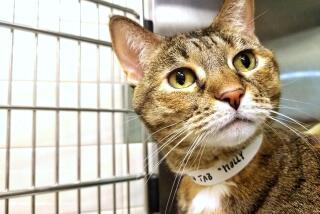‘Simon’s Cat: In His Very Own Book’ by Simon Tofield
- Share via
Simon’s Cat is the new kitty du jour, following in the paw prints of Garfield, Morris, B. Kliban’s cats and other media felines. The creation of British animator-director Simon Tofield, the simply drawn character is the star of five online videos that have racked up more than 36 million hits (they can be seen at simonscat.com). Tofield’s first book brings his popular character to the printed page.
Tofield is a perceptive observer: He understands how cats move and the poses they assume when they sleep, wash, eat and stalk real or imaginary prey. He combines his observations with a sense of caricature that pushes the exaggerations just far enough to reveal what the cat is thinking. And he does it solely through his drawings: Neither the cartoons in the book nor the films contain any words (only meows, purrs and human grunts in the videos), which makes their subject seem that much more believable and cat-like.
Although he began as a recognizable cat, Garfield quickly turned into a crabby little man in a cat suit, complaining about Mondays in a strip designed to be pinned up by the office water cooler -- replacing the previous week’s strip complaining about Mondays. Tofield knows a cat doesn’t care about Mondays: It eats from the same dish, sleeps on the same pillow and gets into the same mischief, regardless of the day of the week.
His understanding of feline psychology enables Tofield to make Simon’s Cat the kitty everyone likes to think he has, just as Snoopy was the dog people imagined they owned before he too became too human. In one drawing, Simon’s Cat sprawls happily across the bed, leaving his owner -- a self-caricature -- clinging precariously to one edge of the mattress. It’s something any cat would do, but Tofield captures the cat’s utter bliss as he stretches from corner to corner. A cat can’t really tackle its owner to get to the food dish faster, but it would if it could, and Simon’s Cat can -- and does. Anyone who’s tried to take a cat to the vet will appreciate a series of drawings of the hapless owner wrestling the cat into his carrier: The expressions on the cat’s face capture the experience and the attitude. Tofield shows how a cat can dodge the swipes of its annoyed owner’s hands while tracking up a clean bedspread, then install itself on the headboard, where the paw prints don’t show. When the owner laboriously assembles a cat tree that should be a feline paradise, the cat ignores it -- and plays in the box it came in.
The “Simon’s Cat” films focus on the cat’s relationship with its put-upon owner, a relationship that revolves around the cat’s demands to be fed. The cartoons in the book allow Tofield to explore other aspects of his character’s impish personality in entirely new adventures. He enjoys teasing the hedgehogs that live in the garden, impaling leaves on their spiny coats like memos on a spindle. He tries unsuccessfully to catch the local birds by disguising himself as a birdhouse. And he pursues an oddly poignant friendship with a garden gnome. The cat clearly thinks the gnome is alive: He takes it fishing with him at a koi pond and tries to play cards with it. The reader recognizes it’s just an inanimate lump of painted plaster, but the cat’s obvious affection for his ersatz chum reveals a gentler side of his nature.
In interviews, Tofield has cited “Calvin and Hobbes” as an influence on his work, especially the magical winter scenes that blend fantasy and reality. In contrast to Bill Watterson’s elegantly calligraphic brushwork, Tofield draws in a minimal style, using simple pen lines with occasional areas of crosshatching. The individual lines are energetic and expressive. They capture the awkward way a cat sprawls when it stretches to wash its stomach, the seemingly boneless appearance of a cat napping in a warm place, and the extraordinary delight cats get from reducing a paper bag to shreds on the carpet.
Tofield’s skill as an animator enables him to depict a cat’s singular mixture of grace and klutziness in sequential drawings. When Simon’s Cat walks across the mantle, he somehow manages to knock every holiday card and the clock onto the floor, and when he jumps onto a freshly waxed table top, the results suggest Fred Astaire trying to tap dance on a patch of ice.
At a time when many comic strips and magazine cartoons read like rewarmed sitcoms and look like they were done with a stencil, Tofield’s scratchy drawings are fresh, original and very, very funny.
Solomon’s “Tale as Old as Time: The Art and Making of ‘Beauty and the Beast’ ” will be published next summer.
More to Read
Sign up for our Book Club newsletter
Get the latest news, events and more from the Los Angeles Times Book Club, and help us get L.A. reading and talking.
You may occasionally receive promotional content from the Los Angeles Times.








